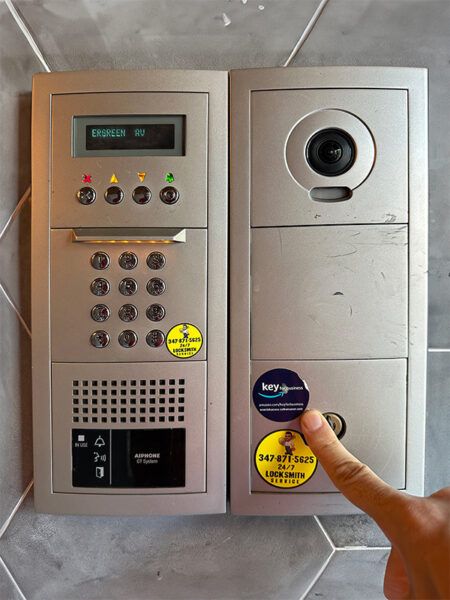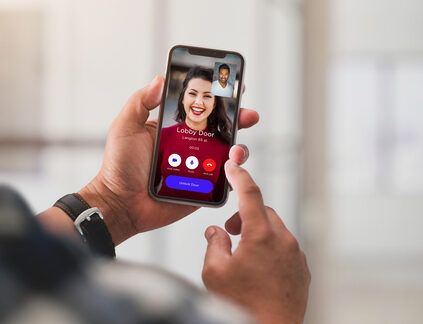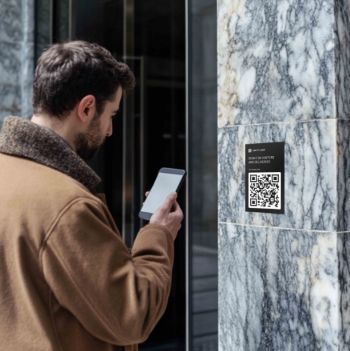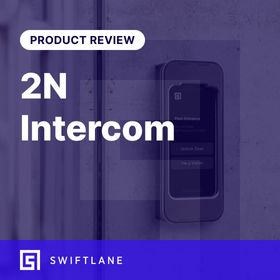Ring In, formerly known as Ring WallCall, is Ring’s new access solution for multi-unit residential buildings created with its parent company, Amazon. Residents control access to their building and screen visitors on live video through the Ring App. Visitors tap their smartphones to a near-field communications (NFC) reader at a building entrance to open a virtual resident directory.
At the time of writing, Ring In was in a soft-launch period with limited marketing and no product pages on the Ring or Amazon websites. We’ve assembled everything about how this product works, who it’s for, and what people say about it. We also cover potential benefits and limitations and what alternative solutions building managers might consider for low-cost multifamily access solutions.
Table of contents
- What Is Ring In?
- How Different User Types Experience Ring In
- Getting Ring In for Your Building
- Potential Benefits
- Potential Drawbacks
- Alternatives to Ring In
What Is Ring In?
Ring + Amazon Key for Business = Ring In for Multi-Unit Buildings
Ring is best known for low-cost, Internet-connected entry solutions for individual homes, such as doorbells, entryway cameras, and intercoms. Amazon acquired Ring in 2018, and since then, it has slowly integrated some of Amazon’s tech.
Ring In represents a new suite of functions, hardware, and software that overlaps Amazon’s existing Key for Business building access architecture in many multi-unit residences. Compared to Amazon Key, it provides a more comprehensive access solution for multi-unit buildings.
The Nuts and Bolts of How Ring In Works
Ring In is a solution for buildings with electronic doors equipped with Amazon Key for Business. Amazon provides and installs Key for Business free of charge in multi-unit residential buildings. It comprises a small computer box behind the door panel with cellular connectivity to communicate with Amazon’s cloud services.
Meanwhile, Ring In layers on four additional technical components:
- Ring In NFC readers installed at building entrances
- Visitors’ smartphones to tap the NFC readers
- Residents’ smartphones with the Ring App installed
- A cloud-based control portal for building management
Amazon’s third-party service can install Ring In NFC readers at a building’s entryways and property gates. The system can also be installed at internal doors for amenities such as gyms, pools, and common rooms. Visually, the NFC readers are simple for visitors. The wall-mounted device is labeled “Call A Resident” and offers a single line of instructions: “Unlock the phone and hold here to open the resident directory website.”
According to a product brochure, the reader’s dimensions are 6.4” x 9.1” x 1.5”, with a 12 hour backup power during an outage. The system is also waterproof, and rated for operations between -40F and 122F. Find a snippet of the product pamphlet here.
How Different User Types Experience Ring In
We gleaned details of how Ring In works for different user types from a company informational brochure, a demonstration video, and conversations with a product salesperson.
Building Residents
Building residents download the Ring App to their smartphones. For now, residents must pull out their phones, open the app, and click unlock to open any Ring In-equipped building doors from anywhere. A salesperson told us that an encrypted NFC system, where residents can tap a card or their smartphone on the Ring In NFC reader to unlock a door immediately, will be rolled out in 2025.
Building Visitors
Building visitors tap their phones at the Ring In NFC readers, which triggers their smartphone web browsers to load a resident directory. From the directory, visitors can select and call residents. To mimic a traditional building video intercom, the visitor’s smartphone camera sends a one-way video feed to the resident’s mobile app, from which the resident can unlock the door. This eliminates the need to install resident directory screens and video cameras at each entryway or video monitors in each apartment since those functions occur on the smartphone.
Property Management
Ring In has a property management portal that management can use to add and remove tenants and control tenants. These tenants can access various doors and gates across a property, including building entrances and internal access to areas like pools, gyms, and shared spaces.
Amazon Key for Business Users
Ring In relies on the underlying infrastructure of Amazon Key for Business to control the door mechanism. Amazon delivery drivers and some authorized third-party delivery personnel can access the building’s main door without ringing a resident using this architecture. It enhances Amazon Key for Business by layering on video and touchscreen capabilities for all potential building visitors, not just delivery people enrolled with Amazon Key for Business.
Getting Ring In for Your Building
How Ring In Gets Installed
We were informed by a customer solutions advisor at Amazon, that Ring In, like its underlying Amazon Key for Business infrastructure, must be professionally installed and hardwired into the building. Amazon uses its contractor network of third-party installation professionals to do the work, which is included in the product’s price. As with Amazon Key for Business, the door must already have an electronic door strike mechanism to add Ring In.
What Ring In Costs
We spoke to the product’s Customer Service for pricing since there was no sales website at the time of our writing. It was available to multi-unit buildings for $499 for the first entry door, which includes both the hardware and installation of the system. Amazon and Ring use a subscription-based model to provide the ongoing cloud-based platform to residents, visitors, and building management, charging the property $3 per month per building unit.
You can install additional controls on both external and internal doors, such as those for a facility gym, pool, or common room, for $399 per door. There is a flat subscription fee of $10 per month per additional door, regardless of the number of units in the building. Those doors must also have electronic door strikes.
Where is the Official Ring In Product Page?
At the time of our publication, neither Ring nor Amazon had published product pages. Therefore, ascertaining how to get the product can be confusing. Amazon, rather than Ring, seemingly handles sales. We contacted Ring’s customer support line the week of July 29, 2024, and multiple support agents did not know about the product. After inquiring with their supervisors, the agents referred us to a Ring WallCall / Customer support team at Amazon.
Amazon’s team explained that the product is rolling out mainly by directly contacting select buildings that already use Amazon Key for Business. Currently, you will only find the system installed in a couple hundred buildings. You can reach Amazon’s Ring In support team at 1-800-915-6251 if you want to obtain the system. As of our writing, Ring’s product support pages still refer to it as Ring WallCall.
Potential Benefits
Nearly Everyone Can Use It
When directly compared to the Amazon Key for Business architecture it is built on, Ring In is an access solution for nearly everyone with a compatible smartphone, not just select delivery drivers.
Low Cost
Ring In has a lower cost compared to a comprehensive video intercom system. Since most communications occur via smartphones, minimal equipment is necessary. You just require an NFC panel and the small Amazon Key for Business unit. What’s more, at the time of this writing, Amazon subsidized the installation by offering a flat rate of $499 for the main entry.
Easy Installation and Minimal Disruption
Amazon contracts the installation through its third-party installer network. You can install the system only at shared access points, not individual apartments. The system also has minimal low-voltage wiring, making it relatively simple.
Potential Drawbacks
We found property managers discussing Ring In on X, formerly Twitter, offering a mix of praise and concern about the product. However, as a relatively new product, there are few sources of comprehensive user reviews. In turn, we independently considered some of this access solution’s potential limitations.
Subscription Model
Unlike some intercom systems with in-building wiring, building management must pay an ongoing subscription fee to Ring/Amazon. Some property managers may prefer more upfront costs to sidestep such ongoing service fees.
It Doesn’t Work Without a Compatible Smartphone
The system would not work for residents or visitors without a compatible smartphone. This can pose a problem for:
- Anyone who has forgotten or misplaced their phone or drained its battery,
- People with older phone models that lack NFC or require complicated setting changes to activate it,
- Unaccompanied minors or anyone without a smartphone as dumb phones make a comeback.
- Experiencing a mobile coverage dead zone at the building entrance is a common problem in urban environments and hilly places like San Francisco.
Access systems that integrate a video intercom and digital directory into the wall mount can avert these problems.
Residents May Find It Clunky to Open Their Door
For now, residents must pull out their smartphones, open the Ring App, and click “unlock” to open their building doors. Quicker systems use key fobs or phone taps to unlock a door immediately. There are also facial recognition-based systems where a resident doesn’t need to pull out anything. Plans are to add a tap feature to the system for residents in 2025.
Amazon Key for Business Has Its Potential Limitations
Our comprehensive guide to Amazon Key for Business found potential limitations, including mixed online reviews and building management complaints about delivery drivers who don’t use the system properly. Others expressed privacy concerns about data Amazon can collect about who accesses buildings. These concerns would all apply to Ring In as well.
How We Researched Ring In
We conducted five hours of Internet research to write this guide, looking at all the written and video materials and user comments we could find about the product. Since the product is new and not heavily marketed, we also spoke with several representatives of Ring and Amazon to learn more about the product and the pricing.
Alternatives to Ring In
Although it is early days for the product, Ring In offers a reasonably low-cost access solution for multifamily residential buildings. However, property managers may want to weigh its potential benefits and limitations against other access solutions in the low-cost category. A potential low-cost alternative with minimal wiring is Swiftlane’s QR Code Intercom, which uses minimal hardware to provide an easy retrofit. You can test the Swiftlane QR Code Intercom by visiting our product page.








